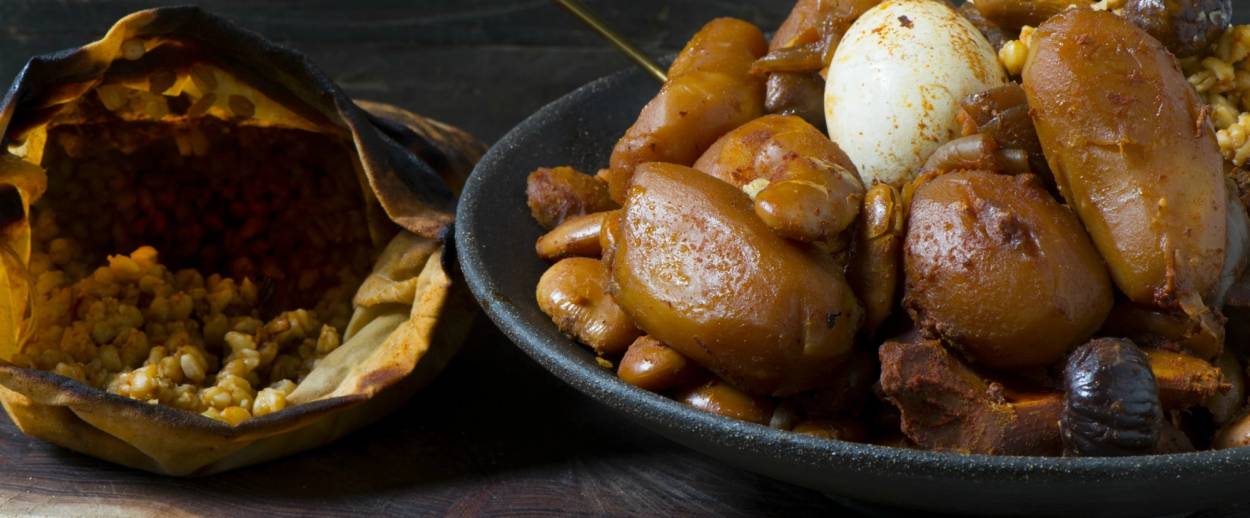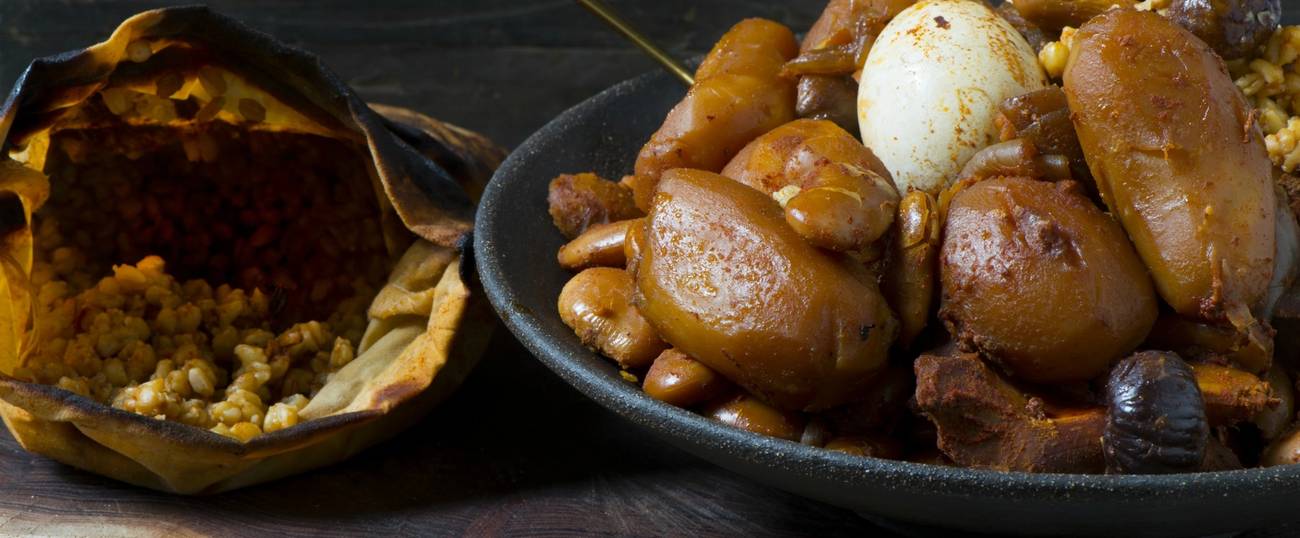The Mysteries of Monsey
Searching for meat and meaning in upstate New York




Judaism’s holy cities are scattered across the world, as far-flung and numerous as the stars in the sky. They’re usually not much to look at—there isn’t a Rome, or even really a Rome, New York in the lot. From Dan to Beer Sheva, from Uman to Lubavitch, from Rego Park to Boro Park, and from the intersection of Avenue J and Ocean Parkway all the way to the intersection of Avenue J and Ocean Avenue, the Jewish people have imbued drab and seemingly anonymous places with sacred meaning and mystery. Superficially, Monsey is a forested highway exit of a town identical to neighboring Mahwah. In fact, they are as different as, say, Morningside Heights is from Har HaBayit itself.
Not that one is any worse or better than the other. There’s no value judgement intended here. Mahwah and Morningside Heights are probably fine places to live. This is more a comment on the metaphysics of a place, which might actually have a negative correlation to quality of life. I don’t know. I’ve spent all of an hour in Monsey. But what an hour it was.
Our story begins at the Monticello Raceway casino, about an hour northwest of Monsey, late this past Tuesday afternoon. The day’s races were long over by then. Judging by the empty grass prairies of parking lot and the monads of borderline-elderly and full-blown elderly slot players suspended in the windowless vacuum of the casino floor, Monticello itself has long been over. The racetrack was built in the 1950s as another diversion for vacationers in the Catskills. Much like the rotting Kutcher’s billboard along Route 17, the sarcophagal glass-enclosed grandstand is a mocking totem of what used to be.
The casino has no table games, but there are machines meant to simulate table games, which seems inherently crooked and ripe for abuse. How many “deals” of video “blackjack” do you have to win before the computer begins to compensate? Why stick around and find out? This logic proved unconvincing, but then, abruptly, very convincing, to my friend and colleague Jonathan Zalman, who lucked into a plush slot machine payout many times higher than the meager $4 I won at video “craps.” Having finally gotten one over on the State of New York, the benevolent giver of fun and amusement tasked with guiding the Monticello raceway to a dignified death, it was time to leave. Tablet director of business development Gabriel Sanders and I had pried Jonathan, and ourselves, from the very belly of She’ol. The state-sponsored mulcting was over before it could be allowed to begin.
The casino was supposed to be one last stop-off at the tail-end of a Tablet day trip to the Catskills, a “when are we gonna be back?” sorta whim among three car-mates. Gabe suddenly recalled a long-ago cholent bender in Monsey, which was, unfortunately, slightly out of the way. But our pockets were newly heavy, and it had been an intolerable three hours since we’d eaten. And on closer examination, Monsey wasn’t really that far out of the way. It was certainly closer than, say, Jerusalem, and also reachable by car.
Gabe issued the tantalizing promise that the one gas station that everyone always says has the best cholent in Monsey doesn’t actually have the best cholent in Monsey. There were better places, and we could go to them.
First stop: bustling Nussy’s Cuisine, a carryout counter sulking in the Monsey-Rama strip mall. Per a sticker in the window, they accept the Chazak Rewards card. Per a sign over the cash register, their Tuesday night special is the pastrami sandwich, for an affordable $10. A flat-screen TV scrolled through headlines of local interest: “Photo essay: Hachnasas Sefer Torah to the Yaroslav Shul,” “Truly Worrisome: Children pickpocketing in Bnei Brak.” Ads flashed by for Sukkah Depot, the one-stop shop for all your sukkah needs—or perhaps you’d prefer the “fold-n-go” sukkah, which, come to think of it, is actually truer to the original spirit and purpose of the sukkah. The screens are property of Sababa Media, and are featured at dozens of locations throughout Monsey.
“Where’s your kippah?” a fellow diner about a head shorter than me asked, more out of curiosity than actual dismay. “Your friends are wearing hats. Where’s yours?” I don’t usually cover my head, I informed him. He responded with a labored pun on “yarmakule” and “Yamaha,” and then joined me at a back table while I tucked into a piping Kugel Deluxe.
The diner at Nussy’s chooses from a cornucopia of kugels. There’s the overnight kugel—round and of unknown filling, time being the operative ingredient. There’s the onion kugel, a plump roll packed with dripping gossamer of slightly browned onion matter. The biggest mystery is the Yaptchik, another round kugel, wherein a tough and abrasively salty carapace of crust protects a foamy potato (possibly) and meat filling, studded with pink chunks of brisket. Gabe theorized that yaptchik—a word that none of our Judaically-aware trio had ever heard before—is an encasement of shabbos leftovers.
In contrast, the kugel deluxe is geshmacht: islands of corned beef rising from an ocean of peppery fried onions under skies of eggy soft crust. It’s a head rush of cholesterol, a stab of life-abridging solidarity with your fellow diners, who are so like and unlike you. It is not, however, cholent—that’s more of a Thursday night, pre-shabbos food, and Nussy’s was fresh out. We’d have to go across town.
Mechel’s, in the Pavilion III strip mall (three for the third temple? I wonder aloud), was totally empty, as if it had always been awaiting our arrival. The area near the cash register was adorned with a photo of the proprietor alongside the Skulener rebbe, head of a rabbinic dynasty that traces its lineage to the Zlotshover Maggid of the late 18th century. This mingling of spiritual exaltation with the mundane requirements of self-sustenance proved wonderfully appropriate. Jonathan ordered a quarter-pound of brisket, and it was like poetry in meat form—gushing deposits of fat traversing buttery cubes of flesh, held together with a tender but pleasantly resistant top layer of fat.
It was a Tuesday, so it’s possible the cholent had been simmering for the better part of a week. Time and beef fat had rendered the beans and potatoes translucent. The stew was steaming and mortar-thick—Zeppelin-like favas wrecked against brown meaty cliffs; every element was gooey-soft and slightly melty, as if it had been cooking forever. This may very well be the primordial cholent, awaiting your grateful jaws since the dawn of cholent itself. I sopped up every last glimmer of moisture, running my fingers along the inside of the plastic container in which it arrived. The price: $3. My gambling winnings had been transmuted into something bordering on the sacred.
Monsey is a bubble: one minute, we were weaving through cars on approach to the packed parking lot of the Bais Rochel school; a few minutes later, we were back on the highway, driving past another failing racetrack-turned-casino, this time outside of Yonkers. But the holy cities exist above and beyond themselves: Fairfax Avenue intersects with Flushing Avenue; Givat Shmuel is just a town over from Golders Green. One bite of cholent, and you’re in all of them at once.
Armin Rosen is a staff writer for Tablet Magazine.